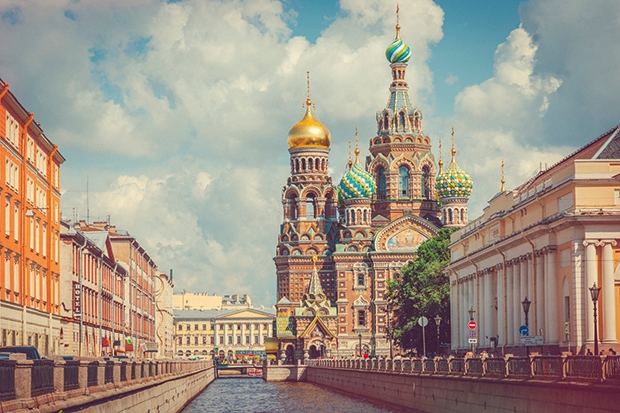Looking across the wide Neva from Vasilyevsky Island, the Palace Embankment shimmers in the river, suspended between water and sky. Raised on a marsh by violence and sheer force of will, there are few cities more impossible, and more beautiful, than St Petersburg. It’s worth going for the view alone, and you should — now, while the rouble is weak.
Thrown up in only 50 years in the 1700s, St Petersburg is a vast stage-set upon which imperial society played at being European. Nowadays, you too can choose your role. Would-be Romanovs can take a box at the Mariinksy and spend one day at the Hermitage, and the next day out at Tsarskoye Selo and the Catherine Palace. Or, on the other hand, you can skulk like Raskolnikov down the back streets and canals, ducking into dive bars and checking out guitar bands.
There is plenty of underground, in both senses of the phrase. St Petersburg is the bohemian student to Moscow’s brash party animal, and the locals have a proud history of telling authority where to stick it. It’s no accident that the birthplace of the Russian Revolution is also the home city of Pussy Riot and Pyotr Pavlensky, the Putin-baiting performance artist who nailed his scrotum to Red Square.
So, when to go? Winters can be cold and summers humid, so May and June are best. The weather is warm and the streets are alive with light-hearted locals who have recently emerged from hibernation. Winter can, with luck, yield brilliant sunshine and clear blue skies, but you’ll have to hedge your bets.
This far north, summer nights consist of a couple of hours of purplish haze before dawn breaks again. Closing time is an alien concept, and with the city’s thriving bar culture (I recommend trying the buckwheat or lingon-berry vodka) it’s hard to know when to call it a night. If you’re staying on one of the islands, getting home has an extra frisson of excitement. The Neva bridges open at scheduled times of night to let shipping through, then stay open for several hours. Cut it fine and the taxi ride becomes a demented scramble to cross the bridge in time.
If you’re staying in a hotel, choose wisely. If you’re very unlucky, you might find radiators that don’t turn off, drilling in the corridor, and a rubbery breakfast buffet. An alternative is to rub shoulders with the locals and take an apartment in a ‘Home Stay’. Andrey and Sasha’s, where I stayed, is full of bohemian charm and backs on to the Griboyedov Canal. The hosts were away when I visited, but their friend Serge — a linen-suited Anglophile, radio presenter and bon vivant — stood in admirably, even inviting me to hear him sing jazz standards at a club called The Hat.
Food-wise, you needn’t worry. You won’t find authentic parmesan here since Russia imposed its retaliatory ban on western food imports. You will, however, find some excellent modern places making a virtue of a necessity and doing impressive things with local produce. And besides, you’ve got the culinary bounty of the former Soviet states to choose from — Ukrainian, Uzbek, Armenian and Georgian, surely the most underrated of all the national cuisines. Some argue that Georgian baked goods are the best in the world — and who am I to disagree?






Comments